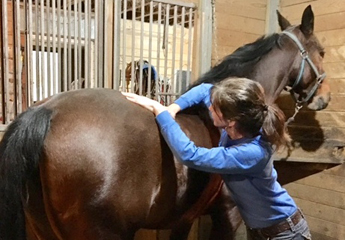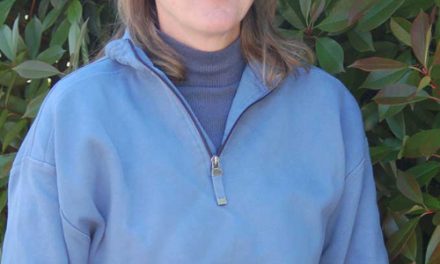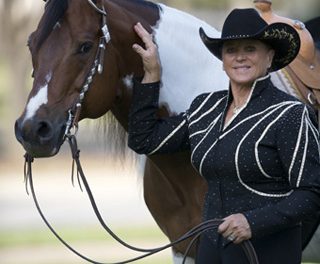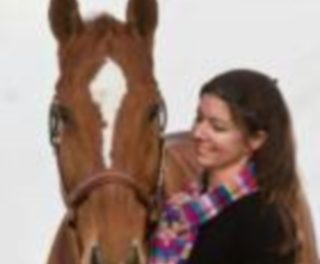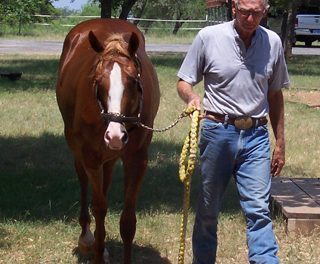The Way of Horses
 Grooming our horses serves a number of functions. It gets the dirt, dust and mud off, it improves circulation and the condition of skin and coat and helps warm up muscles before we ride. It also gives us a chance to spend personal time with our horses doing something they enjoy and gives us pleasure.
Grooming our horses serves a number of functions. It gets the dirt, dust and mud off, it improves circulation and the condition of skin and coat and helps warm up muscles before we ride. It also gives us a chance to spend personal time with our horses doing something they enjoy and gives us pleasure.
Simat Whipp, instructor of the online course, Equine Massage, offered by www.horsecoursesonline.com, says, “Adding some basic massage to the grooming session can improve your horse’s comfort, movement and performance. Potential problems building in the muscles may also be detected.”
As you groom your horse you may notice him flinch or drop away from pressure. If the muscle is tight or sore he may lean into or push back against the pressure, or he may be stiff and brace against your hand. A muscle in good condition will allow your horse to sway and move easily to pressure. Whipp cautions, “If your horse is not used to this kind of touch he may move around a little at first, but once he understands that the pressure helps him relax, he will start to lick and chew and enjoy the session.”
So how can you make your grooming session into a massage session? Below are general guidelines.
Use a fairly stiff rubber (or plastic) curry comb unless your horse is very sensitive. Adjust your pressure for the horse’s level of sensitivity, but use enough to get the horse to yield in its body and go with the pressure, but without causing obvious discomfort. Find a pressure that is suitable for your horse. You’ll be riding a fine line between a pressure that is enough to get the horse’s attention to the fact that you are doing something to its body, but not so much that the horse gets defensive. Watch for soft eyes, licking and chewing, as those are great signs.
You can do massage by going in the same direction as the muscle fibers (going with or against the hair), across the muscle fibers (going across the hair), or in a circular movement that will go both with and across the muscle fibers all at one time.
Slower is better. Use fairly slow, deliberate strokes that give you time to feel and assess what’s under your hand. Fast, vigorous massage is not appropriate when doing grooming massage unless you are getting a horse ready for cross-country, racing or some kind of fast, explosive work.
How do you interpret what you are feeling? A muscle in good condition will have a smooth feel without hard knots. Be aware that if the muscle feels overly smooth, like glass, the horse may be overly tight in that area. As your hand is going down the length of a muscle there should be a smooth glide; if your hand runs into hard or sore spots or a place that stops the smooth flow it indicates tightness that is not consistent with the rest of the muscle. You want to feel smooth, creamy peanut butter, not the chunky kind.
Grooming massage works best on large muscle surfaces such as the long back muscles, the top and sides of the haunches, the shoulders, behind the shoulder and over the ribs, and the sides of the neck. It is best to work in the body of the muscle. Take care when working near the origin and insertion of the muscle fiber. The body of the muscle is generally fairly obvious to the touch. The poll is also a place that benefits from massage.
The horse’s long back muscles are the ones that most commonly will be tight or sore, or both. The most common causes are bad saddle fit and poor riding techniques. Using your curry comb, heel of your hand or finger tips (depending on the horse’s level of sensitivity), start with long gliding strokes that go from the withers to the croup bone. Then, going across the fibers, again work your way down the back from withers to croup, or you could use the circular motion. Your horse will tell you what works best. Do both sides of the back before going on to the haunches.
You will want to massage the top of the haunches (glutei and upper hamstrings) and the sides (quads and lower hamstrings). All three techniques (with the fibers, across fibers or circular) work well here.
When working on the shoulders you may find going up and down the shoulder blades (with the muscles fibers) the most effective. It is awkward to go across the fibers or circular because of the spine of the shoulder blade.
Behind the shoulders and over the ribs will respond well to all three techniques. The area next to the elbow may be particularly tight or “touchy”. The area of the ribs under a rider’s leg is an important place to loosen muscles so that the horse can yield to the pressure of the rider’s leg aids.
The neck can be stiff in many places from its base all the way to the poll. Start at the base and use long gliding strokes that go up the sides of the crest of the neck toward the head. You’ll be going with the fibers (though against the hair growth). Work up the whole surface of both sides of the neck.
Take caution when “rubbing” near the brachiocephalic muscle (the large muscle that runs parallel to the jugular). Feel free to use your rubber curry there, but avoid too much pressure next to the jugular.
Horses generally need a good deal of massage along the crest of their neck. There are 3 major muscles there that can greatly benefit because they are responsible for elongating the neck and allowing good flexion. Massaging this way will encourage your horse to stretch its neck. Most horses enjoy having this done with a flexible rubber curry comb.
The poll can be a sensitive area for many horses. If your horse will let you, use your finger tips to rub all around the ears and over the area just behind the poll. Whipp advises, “Be sure to trim your fingernails because you want only the pads of your fingers to make contact.”
Loosening muscles with massage grooming will make your horse’s body more comfortable and improve its performance, but there is one more advantage. Touching your horse is this manner can aid in overall awareness of where tight or sore area may be prevalent. As you gain awareness of the balance of your horse’s musculature, you will be able to quickly assess potential problem areas. This increased awareness can help you develop exercises under saddle that address problem areas.
This grooming routine can take you beyond just grooming and into a greater awareness and understanding of what may be going on in your horse’s body. One last benefit of your increased awareness of his body is a better ability to know when it is time to get professional advice, be that veterinarian, massage therapist, chiropractor, farrier or equine dentist.
* Take the online course “Equine Massage” taught by Simat Whipp. Please visit www.equinestudiesinstitute.org or email info@equinestudiesinstitute.org for more information. Earn a certificate of completion from Equine Studies Institute.

